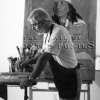
Knauf, J.E.
Second Time's A Charm
Raised in the 1950s in southern California beach towns as part of a business-oriented family, Jim Knauf's road to becoming a successful, full-time artist took a serious turn when he left the West Coast to attend art school at Northern Arizona University, in Flagstaff. While studying the technical aspects of drawing and painting, he took advantage of his college's proximity to the West's ranching and mining communities, as well as the Navajo, Hopi and Apache reservation, traveling the back roads on weekends and holidays, gathering personal impressions and developing an eye for the scenes and subject matter that would later fill his canvases.
In 1970 Jim transferred to the University of California, Irvine, where he earned a Bachelor's Degree in painting. He spent a post-graduate year exploring the art and architecture of Mexico, Europe and North Africa, returning to the States with the intention of pursuing an art career as a painter. Although there was never any doubt about his talent, "I didn't have the knowledge or tools to know how to market my art," Jim admits. Factoring in the new responsibilities of marriage and two sons, Jim was forced to turn his attention to making a living - which led him through a remarkable series of odd jobs and entrepreneurial endeavors. Included were stints refinishing boats, marketing snow-ski products, managing a hotel, and running a restaurant.
In every endeavor his interest in art served him well, especially his work as a swimming pool designer and landscape architect. At the same time, he came to a profound recognition of the importance of marketing and its role in the arts, as well as business. In the mid-1990s he was ready to make another run at the art scene.
The subject of Jim's paintings reflect were, and are, the figures and faces of the American West: craggy Native Americans, fiery dancers, rodeo calf ropers, and whipcord riders on bucking horses. It would be easy to appreciate his paintings on that level alone, but just as memorable are his painting techniques and the materials he uses. He cuts hollow-core doors to size, then fills the edges, creating a wooden surface that is resilient and able to support multiple layers of paint, He covers the surface with an aqueous ground, which consists of swirls of water-thinned gray or golden-tan pigment, and next he uses a fast-drying translucent oil medium to paint the central figure and other elements, applying it in layers. Between layers, he applies glazes that achieve a glassy, mirrored effect, making it appear as though the paint is suspended in the glaze. In some ways, his paintings resemble those of the old masters, yet his bright colors and loose brush strokes make them unmistakably modern.
Over the last ten years, Jim's paintings have had an influence on other "Southwestern" artists for their contemporary command of paint, and edgy representations of real people, working, playing and creating today's Western traditions. His work was recently featured at the opening of The Booth Western Museum in Georgia and was included in the 2003 invitational Buffalo Bill Cody Museum show. He was featured on the cover of Southwest Art magazine, and he is a founding member of THE OTHER SIDE OF THE WEST (link), a distinguished group of contemporary Southwestern artists currently exhibiting paintings at museums around the country. Last but hardly least, he was one of the first artists to welcome the challenge of branding a life-size Pony - Rodeo Dreams - in his inimitable style.
"Rodeo Dreams" can be viewed and ordered as a figurine by clicking here.
Current Ponies by J.E.
- Rodeo Dreams, a collectible figurine inspired by J.E.'s original "Rodeo Dreams".
Additional Information
Residence:
I live in the Moon Valley section of north Phoenix, and I've called this home for the last twenty-one years.
Biggest Artistic Influence:
I hesitate to cite just one because it changes. At one time I'd have said Mark Rothko, an abstract expressionist, for the way he confronts the drama of color and shape. That's not to forget John Singer Sargent, who had a gift for portraiture I admire.
Favorite Song:
The Dark Side of the Moon by Pink Floyd.
Favorite Color:
Red. When I see red it pounds in my brain, even though I use it in only a limited way in my own work.
Favorite Words of Advice:
Let me give you two. One, I co-opted from my wife: "Expectations are premeditated resentments." I don't recall where I heard the other: "Open the front door, open the back door, and let it all blow through."
Personal Hero:
My dad. He died in 1974, at the age of 49, and I've spent the intervening years trying to live up to his moral and ethical example, and keep his great sense of humor alive.


